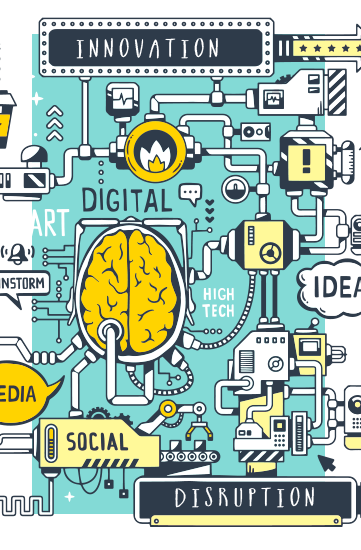BY DR SHAWN CUNNINGHAM
1 JUNE 2022
Over the past two years, we have all lived through the many disruptions caused by the COVID-19 pandemic, flooding, looting and family members walking in during a video call.
But have you paused to think about what it means to be disrupted by a change in technology?
The Merriam-Webster Dictionary defines innovation as “as the act or process of disrupting something: a break or interruption in the normal course or continuation of some activity, process …”
Disruption means that somebody or something is interrupted by somebody or something else. Plans may no longer be valid as priorities have changed. Disruption is more than the promise of new possibilities: it implies inconvenience.
What makes technological disruption hard to manage is that existing competitors are often disrupted by technologies introduced by new entrants with novel offerings underpinned by unexpected business models. Within an industry or a dominant technological domain, many competitors are aware of how markets, technologies and capabilities are incrementally changing along certain trajectories. Often there are standards, norms, supporting institutions and networks that keep everything moving along an almost predictable path. The relative peace might be upset occasionally, as an innovation by an existing player might offer functionality, features or value that requires other competitors to respond. But because existing market players often draw from the same suppliers, supporting organisations, industry associations and even clients, they can usually figure out what needs to be done to respond to the innovation. We could call this kind of disruption a continuous disruption because many of the institutional, market and technology relations will remain the same.
However, when a new offering is launched from outside the mainstream industry or technology domain, it is much harder for existing competitors to figure out how to respond. This is where whole industries can be disrupted by a new entrant that comes in from the side. What makes the catchup or response much harder is that often these “outsiders” used a completely different logic or combined different capabilities to come up with a new business model. As argued by the late Professor Clayton Christensen, who developed the theory of disruption innovation, these disruptors often refine their business models by serving niche markets that are hardly recognised by the dominant market players. Because this kind of disruption also often leads to the creation of completely new markets, new industry networks and different institutions, we refer to this kind of disruption as being discontinuous.
While responding to technological disruption at the level of a company is the responsibility of a management team, shareholders and employees of an affected company, discontinuous disruptions often affect whole industries, markets, supply networks, supporting institutions and possibly even communities. Therefore, governments and other social actors, like universities, labour unions or local councils, are often more concerned about this kind of disruption. Often management teams of companies are so convinced that they are ready for what is coming that they become completely blind to their vulnerabilities, interdependencies or complacency. Often business leaders will try to fight these disruptions by advocating protection mechanisms like duties, regulatory reforms, or even government subsidies to protect their market against new forms of competition. But often, these actions just delay the inevitable demise of lagging industries.
Discontinuous disruption poses a challenge for public and civil society organisations. While technologies seem to change incrementally, institutions change very slowly. Identifying which activities are at risk of being disrupted might be possible for leadership, but designing infrastructure, social and public programmes for an unknown and rapidly changing future is difficult. Just think of how long it takes to design and launch a new degree programme, establish a new technology centre, draft new laws, or retrain retrenched workers to perform new functions. Finally, it is hard to plan for something that is hard to imagine, and it is even harder when planning involves collaborating with stakeholders that have different priorities.
A challenge for all stakeholders affected by discontinuous technological disruptions is that changes are hard to detect, and the signals may be weak at first. New economic activities take time to reflect in statistical data, and by the time they are visible, it may already be too late. The layers of bureaucracy in the public and the private sectors make it harder to recognise that an important shift is emerging, with vested interests concealing that an important change may be unfolding. Furthermore, the companies and markets that may be experimenting with possibly disruptive new technological capabilities are often not that visible or easy to engage with. These leading users are driven to solve a specific problem and may have little interest in a lack of broader institutional adaptation.
The Technological Change and Innovation System Observatory hosted by TIPS is paying careful attention to technologies that may disrupt whole industries, subsectors or value chains. We are looking both at how new technologies are being adopted, and how key sectors or value chains are working together to master new technological capabilities. Where we can, we will highlight shifts in datasets that may be due to technological shifts.



